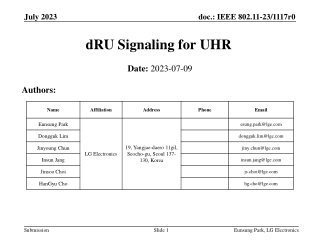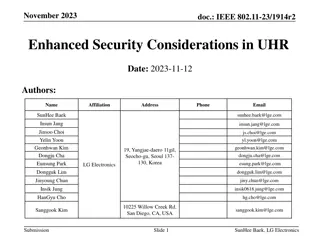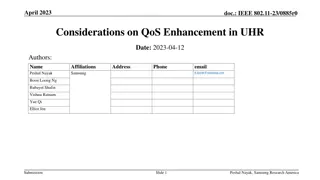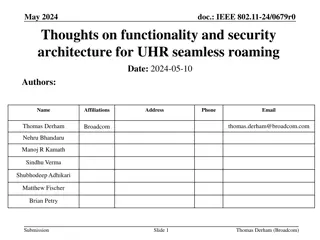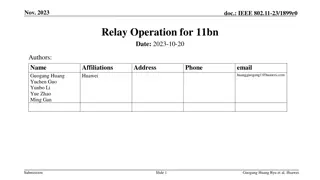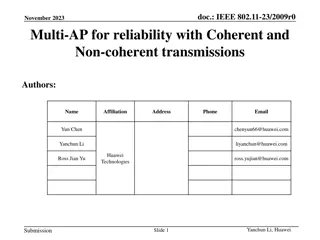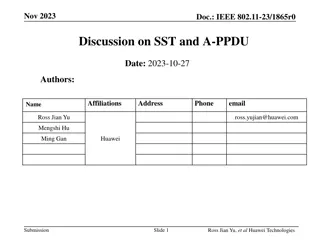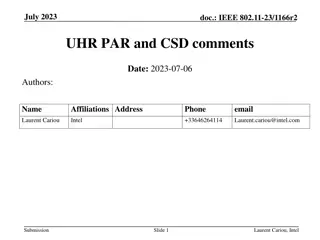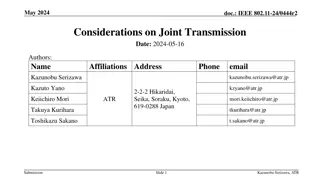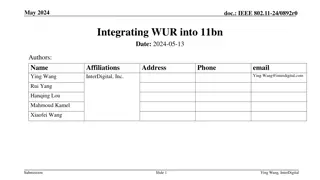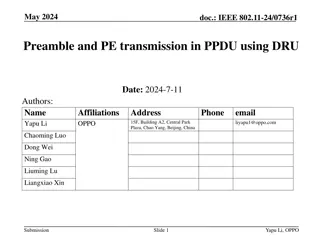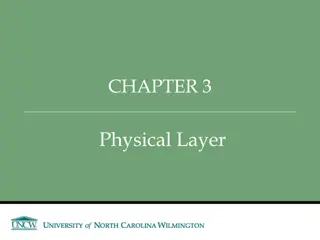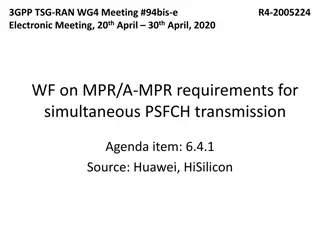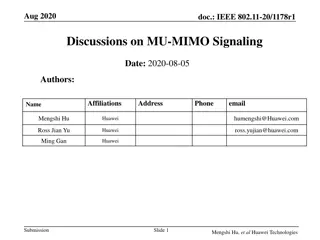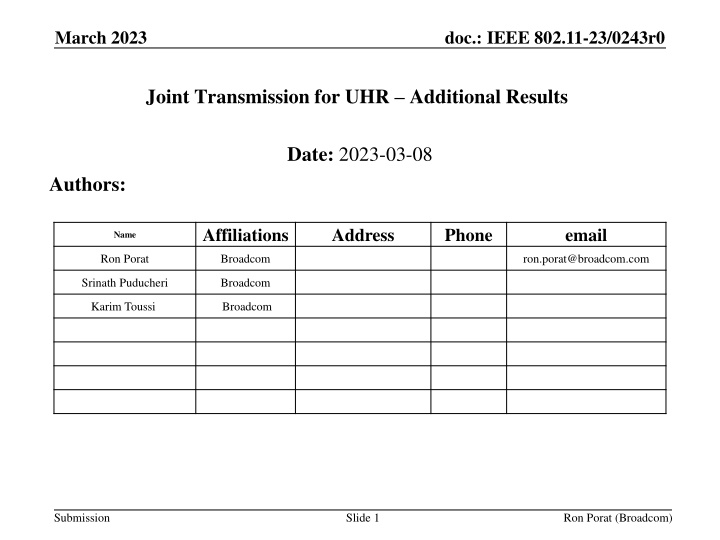
Exploring Joint Transmission Sensitivity in IEEE 802.11-23/0243r0
Delve into the details of joint transmission (JT) sensitivity in IEEE 802.11-23/0243r0, focusing on phase offset drift, simulations with multiple access points, and analysis of spatial streams. Discover insights into optimal transmission configurations and performance improvements in this informative document.
Download Presentation

Please find below an Image/Link to download the presentation.
The content on the website is provided AS IS for your information and personal use only. It may not be sold, licensed, or shared on other websites without obtaining consent from the author. If you encounter any issues during the download, it is possible that the publisher has removed the file from their server.
You are allowed to download the files provided on this website for personal or commercial use, subject to the condition that they are used lawfully. All files are the property of their respective owners.
The content on the website is provided AS IS for your information and personal use only. It may not be sold, licensed, or shared on other websites without obtaining consent from the author.
E N D
Presentation Transcript
March 2023 doc.: IEEE 802.11-23/0243r0 Joint Transmission for UHR Additional Results Date: 2023-03-08 Authors: Affiliations Address Phone email Name Ron Porat Broadcom ron.porat@broadcom.com Srinath Puducheri Broadcom Karim Toussi Broadcom Submission Slide 1 Ron Porat (Broadcom)
March 2023 doc.: IEEE 802.11-23/0243r0 Introduction In our previous contribution 22/2188 we provided a refresher of JT impairments and JT simulations showing improved peak rate and rate vs. range with lower number of spatial streams. In particular we focused on two 4x4AP and showed that transmission of Nss=4 provides substantial gains and is sometimes even optimal. Nss=4 was of interest also because that is what one AP can support on its own In this contribution we expand those results in three directions: Topic A - we examine the sensitivity to phase offset drift Topic B - we simulate three 4x4APs Topic C - we simulate 2x2 APs We provide new insights for each topic and conclude with final remarks Submission Slide 2 Ron Porat (Broadcom)
March 2023 doc.: IEEE 802.11-23/0243r0 Topic A Sensitivity to Phase Offset Recall we previously mentioned that phase drift during JT PPDU needs to be controlled and simulated results with 4 and 8 degrees 8 degrees corresponds to e.g. 20Hz residual frequency offset drifting over 1mS Assumed sync symbol added every 1mS to minimize overhead Here we want to explore how much phase offset we can tolerate. Clearly we need separate investigation for each case of the duple {SNR,X} since low SNR or higher X are less sensitive to impairments. AP1 AP2 SNR SNR-X STA We present results showing at what phase offset the ideal JT gains (as shown on slide 6) drop by 20% and 10% . Submission Slide 3 Ron Porat (Broadcom)
March 2023 doc.: IEEE 802.11-23/0243r0 Simulation Assumptions (as in 22/2188) 2-AP (4x4), each with 2 STA (2x2), 80MHz BW, 11nD, SNR range 10:35dB SNR measured between STA and stronger AP ( serving AP ). Baseline - single-AP + TDMA: Max of DL-MUMIMO Nss=[2 1], DL MU-MIMO Nss=[1 1] Nss=[2 1] is the best for SNR > 20dB. Nss=[1 1] is the best for SNR <= 20dB. JT: AP maintain their power as in baseline. One big MU-MIMO 4 spatial streams: Nss = [1 1; 1 1] of interest for rate/range improvement 6 spatial streams: Nss = [2 1; 2 1] of interest for peak Tput improvement Generic impairments: Channel aging (-30dBc) TxEVM (-35dB, i.e., Tx SNR = -38dBc) NDP channel estimation error (no smoothing). ZF precoder Residual timing estimation error 0.5nS Gain error 1dB New: Phase offset - sweep over [0:0.5:1.5 2:2:32, 40, 60, 90, 120, 180] - we present the highest phase with loss less than or equal to [20%, 10%] Note that one MCS drop means a drop of between 10% and 33% in Tput Submission Slide 4 Ron Porat (Broadcom)
March 2023 doc.: IEEE 802.11-23/0243r0 Phase Offset Impact Analysis The plot below shows the added interference level due to precoder mismatch after a phase drift (as a function of phase shift and X). Similar to the analytical derivation in 19/799 but extending to 180 degrees Note that after 20 degrees the slope moderates - 3dB increase between 60 and 90 and between 90 and 180 Submission Slide 5 Ron Porat (Broadcom)
March 2023 doc.: IEEE 802.11-23/0243r0 Throughput Ratio: Ideal JT (0d, 0ns, 0db) Ideal JT = no synchronization error (simulation itself is not ideal). Note in this case for each SNR value up to 30dB the gains with X=0 are higher than with X>0 due to the power boost at X=0 Throughput ratio for JT with [4ss, 6ss] Serving AP STA SNR (dB) 35 30 25 20 15 10 1.65, 1.93 1.75, 2.01 1.94, 2.16 2.07, 1.95 2.44, 1.73 2.26, 1.65 0 1.62, 1.88 1.75, 1.95 1.80, 1.97 1.94, 1.60 1.95, 1.45 1.92, 1.13 5 1.66, 1.90 1.74, 1.92 1.76, 1.86 1.87, 1.46 1.87, 1.32 1.74, 1.07 10 X (db) 1.68, 1.93 1.74, 1.93 1.76, 1.85 1.85, 1.45 1.85, 1.30 15 1.70, 1.96 1.74, 1.94 1.77, 1.86 1.85, 1.46 20 1.71, 1.98 1.74, 1.95 1.78, 1.87 25 Submission Slide 6 Ron Porat (Broadcom)
March 2023 doc.: IEEE 802.11-23/0243r0 Max phase-offset for [20%, 10%] loss Showing results with Nss=6 for SNR>=25dB and Nss=4 for SNR<=20dB Green cells highlight easier to achieve JT gains with just 10% loss (relative to ideal) Yellow cells highlight somewhere between 10% and 20% loss is achievable Dash (-) means corresponding loss is already exceeded with timing and gain errors alone JT Nss / Serving AP STA SNR (dB) Nss=6 / 35 Nss=6 / 30 Nss=6 / 25 Nss=4 / 20 Nss=4 / 15 Nss=4 / 10 0 4,- 4,- 4,- 10,4 8,4 18,14 5 6,- 6,2 6,1.5 12,8 16,12 32,16 10 10,2 12,6 12,6 24,14 28,22 60,40 X (db) 15 18,8 20,12 22,14 40,28 40,40 20 30,14 32,22 40,28 60,40 25 40,28 60,40 60,40 Submission Slide 7 Ron Porat (Broadcom)
March 2023 doc.: IEEE 802.11-23/0243r0 Summary of phase offset sensitivity The new study shows that there is an easy JT region whereby gains close to ideal are more easily achievable (low to mid SNR and high SNR with X>=10dB) As we noted previously the enterprise scenario is anyway characterized by high X However with good spec design that enables very accurate CFO estimation we can strive to reduce CFO estimation error to the point where <20% loss is achievable apart from a small left top corner of the table We can also show that similar trends are applicable to the other scenarios in this presentation Submission Slide 8 Ron Porat (Broadcom)
March 2023 doc.: IEEE 802.11-23/0243r0 Topic B - Results with Three 4x4AP We expanded the results to three AP as this is a possible scenario in a home mesh deployment and in the enterprise. As with 2AP we assume 2 STA per AP All other simulation results are as with 2 AP (see slide 4, with timing, gain, phase errors are multiplied by +/-1 randomly between the 2 AUX AP) We show the best rate between Nss=6,8,9 (simulated 3ss and 4ss but found they are always lower than 6ss) Main change: we now have two values of X. Provide two sets of results: Symmetric - X1=X2. This is useful for apples to apples comparison with 2AP. Asymmetric AP1 AP2 SNR SNR-X1 STA AP3 SNR-X2 Submission Slide 9 Ron Porat (Broadcom)
March 2023 doc.: IEEE 802.11-23/0243r0 Symmetric X: Throughput Ratio: Ideal JT (0d, 0ns, 0db) Throughput ratio for JT with [6ss, 8ss, 9ss] With 3AP ~3x gains are seen (4x at low SNR & X=0) Serving AP STA SNR (dB) 35 30 25 20 15 10 2.35, 2.86, 2.83 2.63, 2.99, 3.04 3.02, 3.20, 3.40 3.12, 3.52, 3.33 4.05, 3.44, 3.18 4.01, 3.60, 3.02 0 2.33, 2.79, 2.74 2.62, 2.81, 2.93 2.73, 3.02, 3.06 2.97, 2.87, 2.62 3.01, 2.57, 2.34 3.15, 2.57, 1.84 5 2.40, 2.73, 2.75 2.60, 2.77, 2.84 2.57, 2.85, 2.77 2.79, 2.52, 2.17 2.85, 2.19, 2.00 2.62, 1.87, 1.30 10 X (db) 2.48, 2.72, 2.81 2.60, 2.77, 2.84 2.56, 2.73, 2.71 2.75, 2.39, 2.09 2.79, 2.05, 1.91 15 2.53, 2.74, 2.89 2.60, 2.79, 2.88 2.57, 2.69, 2.72 2.74, 2.35, 2.10 20 2.55, 2.78, 2.94 2.61, 2.81, 2.90 2.58, 2.68, 2.75 25 Submission Slide 10 Ron Porat (Broadcom)
March 2023 doc.: IEEE 802.11-23/0243r0 Symmetric X: Throughput Ratio: JT (8d, 0.5ns, 1db) Up to 20dB-25dB 6ss is best (50% loading) similar to trend seen with 2AP Above 25dB 8ss or 9ss are best (67%/75% loading) Impact of X depends on SNR same trend as in 2AP Yellow cells - unlikely scenario (high SNR to all 3 AP!) Serving AP STA SNR (dB) 35 30 25 20 15 10 1.50, 1.48, 1.55 1.69, 1.65, 1.74 2.01, 1.95, 2.00 2.46, 2.35, 1.98 2.95, 2.59, 2.44 3.43, 3.11, 2.79 0 1.58, 1.68, 1.59 1.78, 1.81, 1.76 2.10, 2.02, 1.90 2.40, 2.07, 1.89 2.83, 2.24, 2.08 2.83, 2.34, 1.68 5 1.75, 2.02, 1.98 1.96, 2.17, 2.07 2.33, 2.28, 2.13 2.56, 2.07, 1.93 2.75, 2.10, 1.85 2.56, 1.76, 1.24 10 X (db) 2.15, 2.27, 2.37 2.25, 2.41, 2.49 2.40, 2.51, 2.39 2.69, 2.21, 1.98 2.74, 2.01, 1.85 15 2.30, 2.54, 2.63 2.52, 2.61, 2.71 2.42, 2.60, 2.61 2.72, 2.28, 2.04 20 2.45, 2.67, 2.80 2.59, 2.74, 2.82 2.51, 2.65, 2.70 25 Submission Slide 11 Ron Porat (Broadcom)
March 2023 doc.: IEEE 802.11-23/0243r0 3AP vs. 2AP: Throughput Ratio: JT (8d, 0.5ns, 1db) Best 3AP rate divided by best 2 AP rate for the same {SNR,X} Most cases see close to expected 50% gain (as ideal JT gains are proportional to # of AP). Gray cells - not a significant gain. Serving AP STA SNR (dB) 35 30 25 20 15 10 0 1.17 1.22 1.34 1.39 1.48 1.55 5 1.18 1.19 1.34 1.36 1.50 1.55 10 1.25 1.28 1.41 1.41 1.49 1.58 X (db) 15 1.35 1.37 1.42 1.47 1.49 20 1.41 1.43 1.43 1.48 25 1.44 1.46 1.46 Submission Slide 12 Ron Porat (Broadcom)
March 2023 doc.: IEEE 802.11-23/0243r0 Asymmetric X The logic here is that a STA is not likely to have equal path loss from all three AP (meaning discard (0,0,0) and similar cases) or be very far from 2 out of 3 AP (meaning discard (0,25,25) and similar cases). In the simulation we picked values for X1 and X2 as in the table As before we assume SNR of at least 0dB to each AP X1 X2 X1+X2 (X1+X2)/2 0 10 10 5 STA1 STA2 STA3 STA4 STA5 STA6 5 10 15 7.5 AP1 0 0 X2 X1 X1 X2 5 15 20 10 AP2 X1 X2 0 0 X2 X1 10 15 25 12.5 10 20 30 15 AP3 X2 X1 X1 X2 0 0 15 25 40 20 Submission Slide 13 Ron Porat (Broadcom)
March 2023 doc.: IEEE 802.11-23/0243r0 Asymmetric X: Throughput Ratio: JT (8d, 0.5ns, 1db) Throughput ratio for JT with [6ss, 9ss] (due to asymmetric X discarded 8ss sims) Performance is roughly the average performance seen with the symmetric case for X1 and X2 separately. Serving AP STA SNR (dB) 35 30 25 20 15 10 0,10 1.60, 1.65 1.80, 1.80 2.13, 2.04 2.49, 2.01 2.93, 2.27 3.27, 2.21 5,10 1.68, 1.74 1.88, 1.86 2.18, 2.00 2.44, 1.90 2.77, 1.97 2.65, 1.50 5,15 1.71, 1.90 1.93, 1.99 2.25, 2.08 2.49, 1.93 2.76, 1.95 X1,X2 (db) 10,15 1.90, 2.17 2.04, 2.26 2.37, 2.24 2.63, 1.95 2.75, 1.84 10,20 2.00, 2.27 2.12, 2.37 2.39, 2.30 2.66, 1.97 15,25 2.27, 2.54 2.43, 2.63 2.41, 2.55 Submission Slide 14 Ron Porat (Broadcom)
March 2023 doc.: IEEE 802.11-23/0243r0 Summary of three 4x4AP Simulations Potential gains of 2-3x in most cases Close to 50% gain over 2AP is many cases Same trend is seen as in 2AP JT sims can achieve substantial gains (and in many cases even optimality) with 50% loading (6ss out of 12 antennas, 1ss per STA). 8ss (67% loading) is practically good enough in this case Nss=8 is of interest because that is what JT with 2AP can support at a maximum in other words no need to go above that to support JT with 3AP Note that from a product point of view it may be desirable to not grow the max supported Nss in direct proportion to the number of participating AP in JT. Submission Slide 15 Ron Porat (Broadcom)
March 2023 doc.: IEEE 802.11-23/0243r0 Topic C - Results with 2x2AP We are observing more enterprise volume of 2x2 AP vs. 4x4 AP due to increased cost of adding 6GHz support. Hence decided to check JT with 2x2AP Simulation assumptions similar to those made for 4x4 AP 2 STA per AP (assume same STA density and traffic regardless of # of AP antennas) Baseline - max of {DL-MUMIMO Nss=[1 1], SU-MIMO Nss=[1], Nss=[2]} Nss=[1 1] is the best for SNR >= 20dB. Nss=[1] is the best for SNR <= 15dB. JT - 2AP: Nss = [1 1; 1 1], [1; 1 1], [1; 1] 3AP: Nss = [1 1; 1 1; 1 1], [1; 1 1; 1], [1; 1; 1] Note that in this scenario we went to 100% loading in order to serve all STA so this is not exactly a scale by 2 of 4x4 AP Submission Slide 16 Ron Porat (Broadcom)
March 2023 doc.: IEEE 802.11-23/0243r0 2AP Throughput Ratio: JT (8d, 0.5ns, 1db) Throughput ratio for JT with [2ss, 3ss, 4ss] 4ss superior at SNR>=25dB and SNR=20dB with high X. Otherwise 2ss or 3ss are best. Impact of X depends on SNR same trend as in 4x4AP Yellow cells - less likely scenario Serving AP STA SNR (dB) 35 30 25 20 15 10 0 0.77, 1.04, 1.12 0.87, 1.17, 1.24 1.04, 1.35, 1.29 1.37, 1.65, 1.51 1.97, 2.04, 1.76 2.25, 2.32, 2.00 5 0.89, 1.11, 1.26 0.97, 1.25, 1.37 1.05, 1.39, 1.40 1.38, 1.58, 1.43 1.78, 1.65, 1.53 2.00, 2.03, 1.61 10 1.02, 1.27, 1.47 1.14, 1.34, 1.61 1.20, 1.47, 1.63 1.44, 1.59, 1.56 1.79, 1.58, 1.54 1.98, 1.80, 1.49 X (db) 15 1.12, 1.41, 1.65 1.16, 1.47, 1.71 1.26, 1.49, 1.78 1.45, 1.58, 1.63 1.75, 1.54, 1.61 20 1.21, 1.50, 1.83 1.18, 1.53, 1.78 1.28, 1.49, 1.85 1.45, 1.57, 1.67 25 1.25, 1.54, 1.91 1.20, 1.54, 1.84 1.27, 1.50, 1.88 Submission Slide 17 Ron Porat (Broadcom)
March 2023 doc.: IEEE 802.11-23/0243r0 3AP Throughput Ratio: JT (8d, 0.5ns, 1db) Throughput ratio for JT with [3ss, 4ss, 6ss] 4ss superior at SNR<=15dB while 6ss superior at SNR>=30dB For SNR=20, 25dB 6ss superior with higher X Yellow cells - unlikely scenario Serving AP STA SNR (dB) 35 30 25 20 15 10 1.07, 1.24, 1.27 1.22, 1.40, 1.42 1.42, 1.65, 1.52 1.91, 2.05, 1.75 2.80, 2.98, 2.42 3.76, 3.92, 3.09 0 1.13, 1.33, 1.34 1.29, 1.50, 1.50 1.49, 1.70, 1.59 1.91, 2.00, 1.72 2.30, 2.44, 2.18 2.99, 2.99, 2.25 5 1.32, 1.51, 1.81 1.44, 1.69, 1.95 1.56, 1.89, 1.94 2.00, 2.12, 1.90 2.31, 2.33, 2.10 2.96, 2.70, 1.86 10 X (db) 1.51, 1.78, 2.21 1.70, 1.88, 2.41 1.73, 1.97, 2.42 2.12, 2.17, 2.28 2.37, 2.32, 2.23 15 1.66, 1.92, 2.48 1.74, 2.04, 2.57 1.86, 2.00, 2.65 2.16, 2.19, 2.41 20 1.76, 2.07, 2.75 1.74, 2.10, 2.65 1.87, 2.01, 2.73 25 Submission Slide 18 Ron Porat (Broadcom)
March 2023 doc.: IEEE 802.11-23/0243r0 Summary of 2x2AP Simulations JT with 2x2AP helps achieving real MU-MIMO gains which are not possible in 2x2AP on their own Similar performance trends as seen with 4x4 AP, however supporting 100% loading is more useful (and easier to support) in this case: For 2AP scenarios in order to be able to support a total of 4ss. For 3AP in quite wide SNR range 6ss is optimal. Submission Slide 19 Ron Porat (Broadcom)
March 2023 doc.: IEEE 802.11-23/0243r0 Concluding Remarks Based on simulations of 2x2 and 4x4AP in 2AP and 3AP configurations we conclude that JT performance sensitivity to impairments is a gray area - it is likely always possible to achieve close to optimal gains in either low to medium SNR or high SNR with X>=10. Specifically: Rate vs. range improvement is easier to achieve with JT (compared to peak Tput gains) and provides gains for STA potentially needing it more (those at low to medium SNR) Peak Tput gains for JT are easier with at least 10dB SNR differential A practical implementation of JT therefore needs to consider the relative SNR of STA-AP pairs before deciding on the right candidates. This information is also important for other M-AP schemes such as CSR and CBF Submission Slide 20 Ron Porat (Broadcom)

